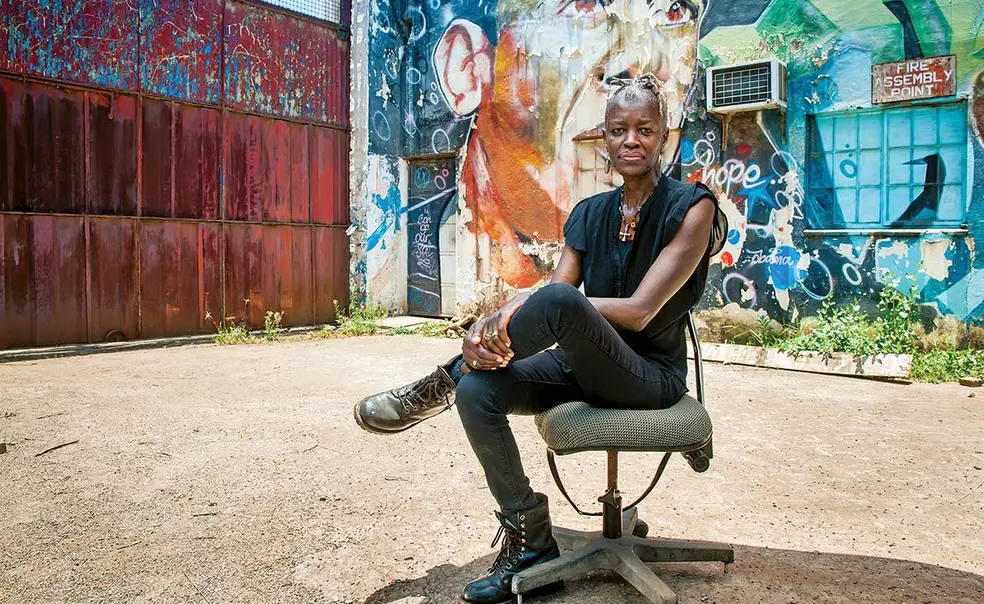Joy Mboya ’85 Is Developing Artists in Kenyan Communities
Mboya’s GoDown Arts Centre is the largest multidisciplinary arts space in East Africa
In 1989, Joy Mboya ’85 was an architect by day and sang in a band by night. She had returned to her hometown, Nairobi, Kenya, after Princeton, and eventually she and her bandmates quit their jobs to devote themselves to Musikly Speaking, their all-women group, which blended Kenyan folk songs and Western harmonies. “Women in popular music in Nairobi was quite unusual,” she says.
The band broke up, and Mboya earned a postgraduate degree in voice studies at the National Institute for Dramatic Arts in Australia. When she returned to Nairobi, she didn’t pursue architecture or singing. Instead, she set out to create a place that would mentor young artists.
“I felt compelled to return home and try to make a change, because while we have many talented people in Kenya, we do not have sufficient training opportunities for the arts sector,” she says. “The arts had little or no priority in the education system, so if you were an artist, you learned from older, more experienced artists; short, sporadic workshops; or you taught yourself.”
In 2003, Mboya co-founded the GoDown Arts Centre, the first — and currently the largest — multidisciplinary space for the arts in East Africa. The Ford Foundation, which had committed to supporting arts, culture, and media in East Africa, provided the initial funding. The center opened in a warehouse on the edge of Nairobi’s industrial quarter, a location that is accessible for the mid- and low-income Nairobians whom the center serves. In 2017, the center announced that it would knock down its current facility and build a four-story building, tripling its size.
The 100,000-square-foot space has hosted exhibitions, performances, workshops, and discussions for all manner of creative arts, including dance, music, film, puppetry, fashion, acrobatics, and visual arts such as painting and sculpture. Each year, the center supports more than 500 artists and welcomes more than 100,000 people to its events. About half are school-age children and young adults.
The center’s mission is to help answer the question, “How do the arts give you a voice in a democratic space and enable you to fulfill yourself, and how does this contribute to a culturally confident, creative, and prosperous Kenya nation?” says Mboya, who is the center’s executive director. “The arts can be seen as an elitist activity. We try to make the case that they don’t have to be, that art is for everybody. And we want to inculcate a sense of ownership and pride for our local creativity within the community.”
The center’s annual events are touchstones for the community. The Nai Ni Who festival — the name asks, in the vernacular, “Who is Nairobi?” — is a celebration of and conversation about the city. The Manjano art contest invites established artists and students to submit their work — more than 340 submissions came in 2019. The center offers many youth programs, with a focus on empowering young women and providing career training. It also offers subsidized artists’ studios.
In its early days, the center concentrated on providing artists with a venue to present their work, but it expanded its focus to help artists’ development, especially their business skills. Its entrepreneurship course provides nine weeks of instruction in branding, finance, marketing, and building networks. More than 200 people — from fashion designers and filmmakers to graphic artists and talent managers — have taken the course.
The new facility will feature a museum, galleries, a multipurpose auditorium, a library, and a youth center, as well as artist studios and other creative workspaces. More than $1 million has been raised locally for the project so far. Construction was suspended in 2020 because of the pandemic; Mboya hopes work will resume in 2022. The center has continued operating several programs online, including one that connects Somali and Kenyan artists. When it is completed, says Mboya, the new center “will be a space of imagination, a place to see the potential of communities, individuals, and the nation to express their creativity.”












No responses yet